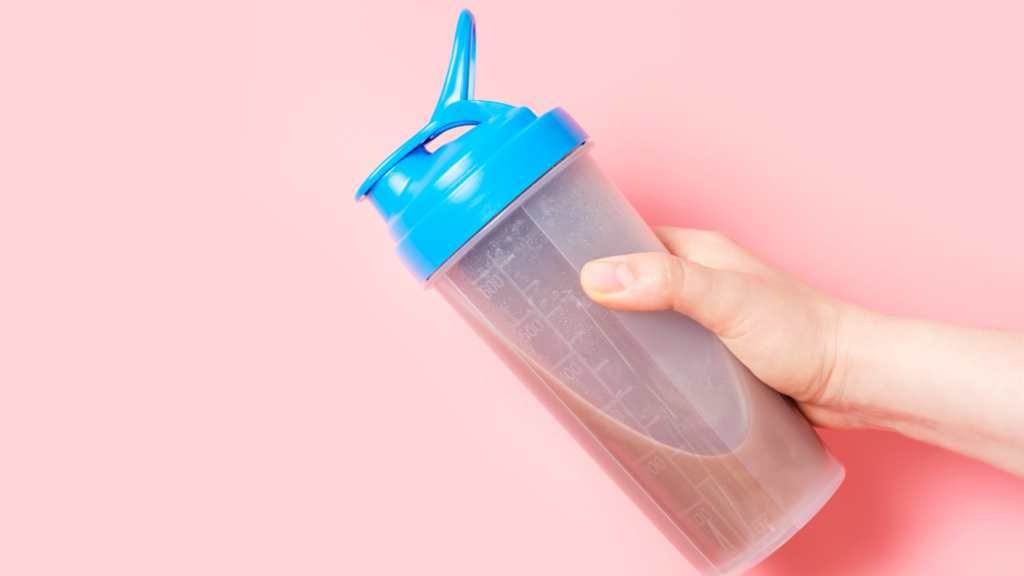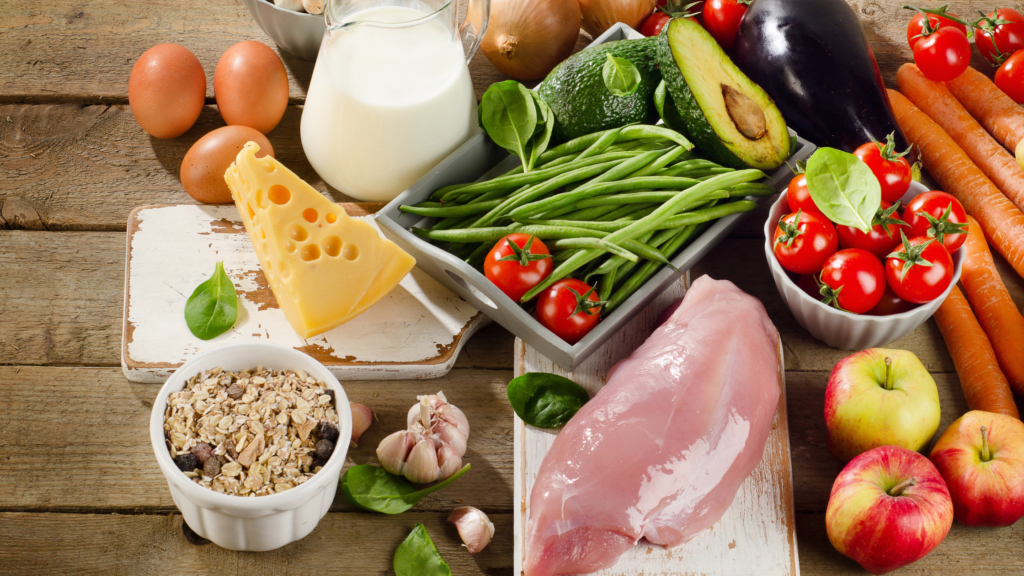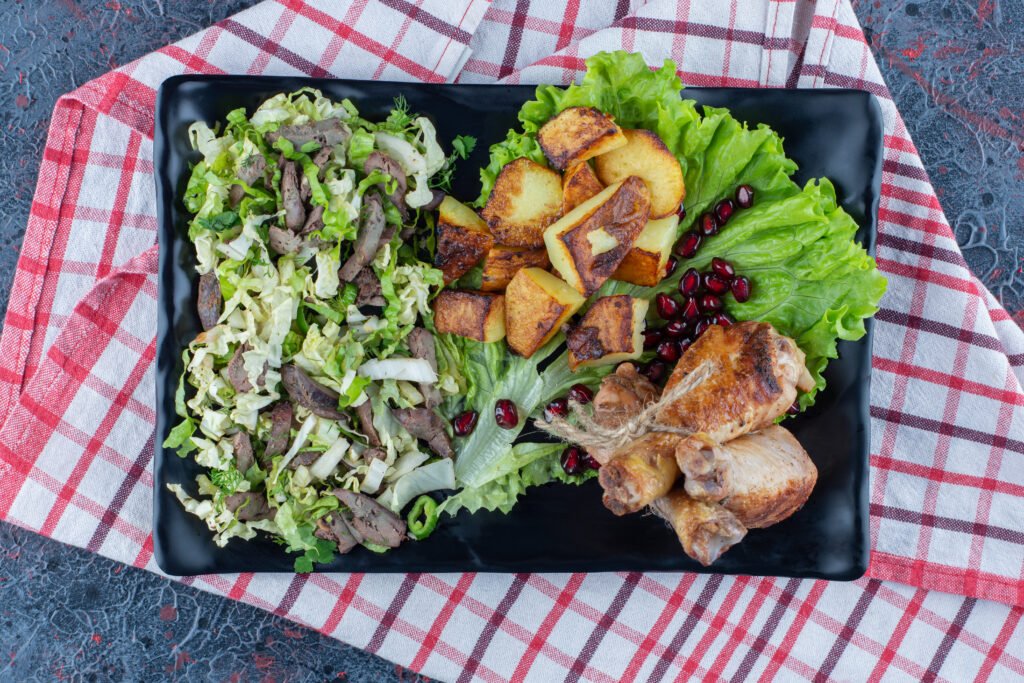Discover the ultimate guide to achieving your fitness goals with ‘The Perfect Plate: Best Foods for Fat Loss and Muscle Gain!’ Uncover the power-packed foods that will supercharge your journey to a healthier, stronger you.
Table of Contents
INTRODUCTION :
Introducing the topic of nutrition as a crucial aspect of achieving fat loss and muscle gain goals is paramount to setting the context for understanding the significance of dietary choices in shaping one’s physique and fitness outcomes.
Nutrition serves as the cornerstone of any fitness endeavor, playing a pivotal role in determining whether one succeeds in shedding excess body fat or building lean muscle mass. It goes beyond mere sustenance; it’s the very foundation upon which the body’s transformation is built.
For individuals striving to achieve fat loss, understanding the intricacies of nutrition is essential. It’s not simply about slashing calories or embarking on crash diets; rather, it involves making informed choices about the types of foods consumed, their nutrient composition, and their impact on metabolism and energy balance.
Throughout this blog post, we’ll get to know the best foods for fat loss and muscle gain, exploring the best foods, dietary strategies, and lifestyle habits to support your journey toward a healthier, fitter you. From understanding macronutrients to practical tips for meal planning and mindful eating, we’ll equip you with the knowledge and tools needed to optimize your nutrition for success. So, let’s dive in and uncover the secrets to achieving your fat loss and muscle gain goals through the power of nutrition.
WHAT IS FAT LOSS AND MUSCLE GAIN ?
Fat Loss: Fat loss, also known as weight loss, refers to the reduction of body fat mass. It occurs when the body burns more calories than it consumes, leading to a decrease in overall body fat percentage. Fat loss can be achieved through various methods, including dietary changes, increased physical activity, and lifestyle modifications. It is often a primary goal for individuals looking to improve their health, appearance, and overall well-being. Effective fat loss strategies focus on creating a calorie deficit, where the body uses stored fat as fuel for energy, resulting in a decrease in body weight and fat stores over time.
Muscle Gain: Muscle gain, also referred to as muscle hypertrophy, involves increasing the size, strength, and mass of skeletal muscle tissue. It occurs in response to resistance training (such as weightlifting) and adequate protein intake, which stimulate muscle protein synthesis, the process by which new muscle proteins are created. Muscle gain is characterized by an increase in muscle fiber size and cross-sectional area, resulting in enhanced muscle definition, strength, and functionality. It is a common goal among athletes, fitness enthusiasts, and individuals seeking to improve their physical performance, aesthetics, and overall functional capacity. Effective muscle gain strategies involve progressive overload, proper nutrition, sufficient rest and recovery, and consistency in training.
IMPORTANCE OF NUTRITION FOR FAT LOSS AND MUSCLE GAIN :

Whether your goal is fat loss or muscle gain, managing your caloric intake is key. To lose fat, you generally need to consume fewer calories than you expend (caloric deficit). Conversely, to gain muscle, you typically need to consume more calories than you expend (caloric surplus).
Protein, carbohydrates, and fats are the three macronutrients essential for supporting fat loss and muscle gain. Protein is particularly crucial for muscle repair and growth, while carbohydrates provide energy for workouts and replenish glycogen stores. Healthy fats are vital for hormone production and overall health.
Adequate protein intake is critical for muscle repair and growth. Aim for around 1.6-2.2 grams of protein per kilogram of body weight per day, depending on your activity level and goals.
Timing your meals around workouts can optimize performance and recovery. Consuming protein and carbohydrates before and after workouts can enhance muscle protein synthesis and replenish glycogen stores.
Remember, individual needs vary based on factors like age, gender, weight, metabolism, and activity level. Consulting with a registered dietitian or nutritionist can provide personalized guidance tailored to your specific goals and needs.
IMPORTANCE OF PROTEIN IN MUSCLE REPAIR AND GROWTH:
Protein is essential for muscle repair and growth due to its role in muscle protein synthesis. When you engage in activities like weightlifting or resistance training, you create micro-tears in your muscle fibers.
Protein provides the necessary building blocks, amino acids, to repair these tears and build new muscle tissue, resulting in increased muscle size and strength over time.
Therefore, consuming an adequate amount of protein is crucial to support these processes and optimize your muscle recovery and growth.
LIST OF SOME OF THE BEST PROTEIN SOURCES :
- Lean Meats:

- Chicken breast
- Turkey breastLean cuts of beef (e.g., sirloin, tenderloin)
- Pork tenderloin
2. Fish:

- Salmon
- Tuna
- Trout
- Cod
- Tilapia
3. Eggs and Egg Whites:

- Whole eggs
- Egg whites (low in calories and high in protein)
4.Dairy:

- Greek yogurt (unsweetened)
- Cottage cheese (low-fat or fat-free)
- Skim or low-fat milk
- Cheese (in moderation due to higher fat content)
5. Legumes:

- Lentils
- Chickpeas
- Black beans
- Kidney beans
- Peas
6.Plant-Based Options:

- Tofu
- Tempeh
- Edamame
- Seitan
- Quinoa
- Soy milk
- Plant-based protein powders (pea protein, brown rice protein, hemp protein)
7.Nuts and Seeds (in moderation due to higher fat content):

- Almonds
- Walnuts
- Chia seeds
- Flaxseeds
- Pumpkin seeds
8. Soy Products:

- Soybeans
- Soy milk
- Tofu
- Tempeh
9. Poultry:

- Chicken (skinless)
- Turkey (skinless)
10. Protein Supplements (when whole food sources are not available or convenient):

- Whey protein
- Casein protein
- Plant-based protein powders
TIPS ON HOW TO INCORPORATE ADEQUATE PROTEIN INTO EACH MEAL:
Include protein-rich foods like eggs, Greek yogurt, cottage cheese, or protein smoothies into your breakfast. Try adding vegetables or lean meats to your omelets or scrambled eggs for an extra protein boost.
Keep protein-rich snacks on hand, such as Greek yogurt, hard-boiled eggs, cheese sticks, nuts, or protein bars. These can help you meet your protein goals between meals and keep hunger at bay.
Make protein the centerpiece of your meals by including lean meats, poultry, fish, tofu, tempeh, legumes, or plant-based protein sources like quinoa or lentils. Aim to fill about a quarter to a third of your plate with protein-rich foods.
Prepare large batches of protein-rich foods like grilled chicken, baked tofu, or beans at the beginning of the week. Store them in the fridge or freezer for quick and convenient meal prep throughout the week.
Protein supplements like protein powder can be a convenient way to boost your protein intake, especially if you’re on the go or need a quick post-workout option. Blend protein powder into smoothies or mix it with water or milk for a quick protein boost.
By incorporating these strategies into your meal planning and food choices, you can ensure that you’re getting an adequate amount of protein at each meal to support your fat loss and muscle gain goals.
THE ROLE OF CARBOHYDRATES IN PROVIDING ENERGY AND RECOVERY:
Carbohydrates serve as the primary source of energy for workouts by providing glucose, which fuels muscle activity during exercise.
They are stored in the body as glycogen, which is readily available for use during physical activity. Consuming carbohydrates before exercise ensures glycogen stores are adequately stocked, improving performance and endurance.
After workouts, carbohydrates are crucial for replenishing glycogen stores, supporting muscle recovery, and preventing fatigue. In summary, carbohydrates are essential for fueling workouts and facilitating recovery, ensuring optimal performance and adaptation to exercise.
SOME OF THE BEST CARBOHYDRATE SOURCES FOR FAT LOSS AND MUSCLE GAIN :
1 . Whole Grains:

- Brown rice
- Quinoa
- Oats (steel-cut or rolled)
- Barley
- Bulgur
- Whole wheat pasta
- Whole grain bread (such as whole wheat or sprouted grain)
2 . Fruits:

- Berries (strawberries, blueberries, raspberries)
- Apples
- Bananas
- Oranges
- Kiwi
- Grapefruit
- Pineapple
- Mango
3 . Vegetables (Non-Starchy):

- Leafy greens (spinach, kale, arugula)
- Broccoli
- Cauliflower
- Bell peppers
- Cucumber
- Zucchini
- Tomatoes
- Mushrooms
4 . Starchy Vegetables:

- Sweet potatoes
- Potatoes (white or red)
- Butternut squash
- Acorn squash
- Pumpkin
- Beets
5 . Legumes:
- Black beans
- Chickpeas (garbanzo beans)
- Lentils
- Kidney beans
- Peas
6 . Dairy (for those who tolerate lactose well):

- Milk (low-fat or fat-free)
- Yogurt (plain, unsweetened)
- Kefir
7 . Nuts and Seeds (in moderation due to their higher fat content):

- Almonds
- Walnuts
- Chia seeds
- Flaxseeds
- Pumpkin seeds
8 . Whole Grain Snacks:

- Air-popped popcorn
- Whole grain rice cakes
- Whole grain crackers
THE IMPORTANCE OF CHOOSING COMPLEX CARBOHYDRATES OVER SIMPLE SUGAR :
Complex carbohydrates are made up of longer chains of sugar molecules, which take longer to break down and digest compared to simple sugars. This results in a slower release of glucose into the bloodstream, providing a more sustained source of energy. In contrast, simple sugars can cause rapid spikes and crashes in blood sugar levels, leading to fluctuations in energy levels and increased feelings of hunger.
Complex carbohydrates are often higher in fiber, which adds bulk to your diet and helps you feel fuller for longer. This can aid in appetite control and weight management by reducing the likelihood of overeating and snacking between meals. Simple sugars, on the other hand, lack fiber and can leave you feeling unsatisfied and craving more food.
Many complex carbohydrate sources, such as whole grains, fruits, and vegetables, are rich in essential nutrients like vitamins, minerals, and antioxidants. Choosing these nutrient-dense options provides additional health benefits beyond just providing energy. In contrast, foods high in simple sugars, like candy, soda, and pastries, often lack these beneficial nutrients and can contribute to nutrient deficiencies when consumed in excess.
Diets rich in complex carbohydrates have been associated with a lower risk of chronic diseases such as heart disease, diabetes, and certain cancers. Choosing complex carbohydrates as the primary source of energy can contribute to overall health and well-being over the long term.
In summary, opting for complex carbohydrates over simple sugars provides a more sustained source of energy, promotes satiety, offers greater nutrient density, helps stabilize blood sugar levels, and supports long-term health goals.
IMPORTANCE OF HEALTHY FATS IN DIET :
Incorporating healthy fats into the diet is paramount for hormone regulation and satiety.
Fats are essential for the synthesis and regulation of hormones, including insulin, testosterone, estrogen, and cortisol, which play pivotal roles in metabolism, energy balance, growth, and stress response. Balanced hormone levels are critical for maintaining optimal health, supporting energy levels, and regulating body composition. Healthy fats also aid in satiety by providing a source of long-lasting energy.
Unlike carbohydrates and protein, fats are more slowly digested and absorbed, helping to sustain feelings of fullness and satisfaction between meals. Including healthy fats in meals can help prevent overeating and cravings, supporting weight management goals and promoting overall dietary adherence.
SOME OF THE BEST SOURCES OF HEALTHY FATS:
- Avocado
- Nuts (almonds, walnuts, cashews, etc.)
- Seeds (chia seeds, flaxseeds, pumpkin seeds, etc.)
- Fatty fish (salmon, mackerel, trout, sardines, etc.)
- Olive oil
- Coconut and coconut oil
- Nut butters (almond butter, peanut butter, etc.)
- Flaxseed oil
- Chia seed oil
HOW TO BALANCE PROTEIN, CARBOHYDRATES AND FATS ON YOUR PLATE FOR BEST RESULTS :

Here’s a simple way to visualize the balance on your plate:
- Fill half of your plate with non-starchy vegetables.
- Reserve a quarter of your plate for lean protein.
- Use the remaining quarter for complex carbohydrates.
- Add a serving of healthy fats, such as a drizzle of olive oil or a sprinkle of nuts or seeds, as needed.
Adjust portion sizes based on your individual calorie and macronutrient needs, as well as your specific fat loss and muscle gain goals. Remember to stay hydrated and listen to your body’s hunger and fullness cues to ensure you’re meeting your nutritional needs while supporting your fitness goals. If you have specific dietary requirements or preferences, consider consulting with a registered dietitian or nutritionist for personalized guidance.
HERE ARE SOME SAMPLE MEAL IDEAS AND RECIPES THAT CAN SUPPORT BOTH FAT LOSS AND MUSCLE GAIN:
BREAKFAST :
- Greek Yogurt Parfait

- Ingredients:
- Greek yogurt (plain, unsweetened)
- Mixed berries (strawberries, blueberries, raspberries)
- Granola (look for a lower sugar option)
- Optional: drizzle of honey or sprinkle of chia seeds
- Instructions:
- Layer Greek yogurt, mixed berries, and granola in a bowl or glass.
- Repeat layers as desired.
- Top with a drizzle of honey or sprinkle of chia seeds for extra flavor and nutrition.
2. Vegetable Omelette

- Ingredients:
- Eggs (whole or egg whites)
- Mixed vegetables (spinach, bell peppers, onions, tomatoes)
- Feta cheese (optional)
- Olive oil or cooking spray
- Instructions:
- In a bowl, whisk together eggs or egg whites.
- Heat olive oil or cooking spray in a non-stick skillet over medium heat.
- Add mixed vegetables to the skillet and sauté until softened.
- Pour the whisked eggs over the vegetables and cook until the eggs are set.
- Serve hot with a side of whole grain or fruit.
LUNCH :
1 . GRILLED CHICKEN SALAD :

- Ingredients:
- Grilled chicken breast (sliced)
- Mixed greens (spinach, arugula, lettuce)
- Cherry tomatoes
- Cucumber
- Red onion
- Avocado
- Balsamic vinaigrette dressing
- Instructions:
- Toss mixed greens, cherry tomatoes, cucumber, and red onion in a large bowl.
- Top with sliced grilled chicken breast and avocado.
- Drizzle with balsamic vinaigrette dressing and toss to combine.
- Serve as a hearty and nutritious salad.
2 . QUINOA WITH BLACK BEAN BOWL :

- Ingredients:
- Cooked quinoa
- Black beans (canned or cooked from dry)
- Roasted sweet potatoes
- Sautéed bell peppers and onions
- Guacamole or sliced avocado
- Salsa
- Instructions:
- In a bowl, layer cooked quinoa, black beans, roasted sweet potatoes, and sautéed bell peppers and onions.
- Top with a dollop of guacamole or sliced avocado and salsa.
- Optional: add a squeeze of lime juice and sprinkle of cilantro for extra flavor.
DINNER :
1 . BAKED SALMON WITH ROASTED VEGETABLES :

- Ingredients:
- Salmon fillets
- Asparagus
- Cherry tomatoes
- Zucchini
- Olive oil
- Lemon
- Garlic powder, salt, and pepper
- Instructions:
- Preheat oven to 400°F (200°C).
- Place salmon fillets on a baking sheet lined with parchment paper.
- Drizzle salmon with olive oil and season with garlic powder, salt, and pepper.
- Arrange asparagus, cherry tomatoes, and sliced zucchini around the salmon on the baking sheet.
- Drizzle vegetables with olive oil and season with salt and pepper.
- Bake in the preheated oven for 15-20 minutes, or until salmon is cooked through and vegetables are tender.
- Serve hot with a squeeze of lemon juice.
2 . TURKEY AND VEGETABLE STIR-FRY :

- Ingredients:
- Lean ground turkey
- Mixed vegetables (broccoli, carrots, bell peppers, snap peas)
- Low-sodium soy sauce
- Garlic
- Ginger
- Brown rice or quinoa
- Instructions:
- Cook brown rice or quinoa according to package instructions.
- In a large skillet or wok, heat olive oil over medium heat.
- Add lean ground turkey to the skillet and cook until browned.
- Add minced garlic and ginger to the skillet and cook until fragrant.
- Add mixed vegetables to the skillet and stir-fry until tender-crisp.
- Drizzle low-sodium soy sauce over the turkey and vegetables and toss to combine.
- Serve hot over cooked brown rice or quinoa.
These sample meals provide a balance of protein, carbohydrates, and healthy fats to support both fat loss and muscle gain goals. Feel free to adjust portion sizes and ingredients based on your individual nutritional needs and preferences. Enjoy!
Also Read: The Truth Behind Anne Hathaway’s Weight Loss: Debunking Myths and Rumors
CONCLUSION:
Crafting the perfect plate or best foods for fat loss and muscle gain involves thoughtful consideration of the foods we choose to fuel our bodies.
By prioritizing nutrient-dense options and striking a balance between protein, carbohydrates, and healthy fats, we can optimize our nutrition to support our fitness goals.
From lean proteins like chicken and salmon to complex carbohydrates such as quinoa and sweet potatoes, and incorporating healthy fats like avocado and olive oil, each component plays a vital role in enhancing performance, promoting satiety, and facilitating muscle repair and growth.








